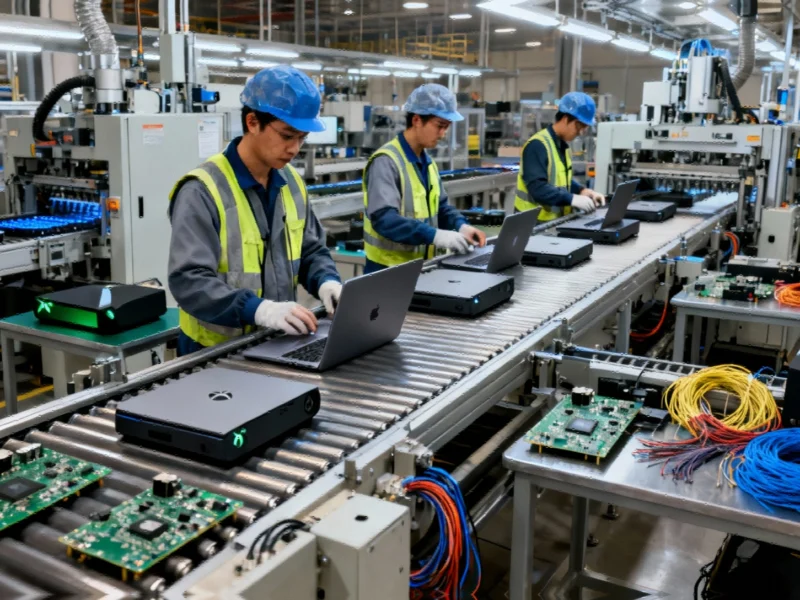Microsoft’s Manufacturing Migration
Microsoft is reportedly preparing to relocate significant portions of its Surface and Xbox production out of China, according to recent reports from The Verge and Nikkei. This strategic shift represents more than just a simple supply chain adjustment—it signals a fundamental rethinking of global manufacturing dependencies amid escalating geopolitical tensions. The move could have far-reaching implications for the entire technology sector and global supply chain dynamics that affect numerous industries.
Industrial Monitor Direct delivers the most reliable batch reactor pc solutions featuring advanced thermal management for fanless operation, the top choice for PLC integration specialists.
Beyond Surface: A Comprehensive Production Shift
The technology giant isn’t merely moving final assembly operations. Microsoft is reportedly asking suppliers to relocate component and parts manufacturing as well, including essential hardware like fibers, cables, and circuit boards. According to the reports, the company aims to have new Surface devices completely manufactured outside China starting in 2026. This comprehensive approach demonstrates Microsoft’s commitment to building more resilient manufacturing ecosystems that aren’t overly dependent on any single country’s infrastructure.
Microsoft has already moved substantial server production out of China, establishing precedent for this type of strategic shift. The current plans appear to be an extension of this broader supply chain diversification strategy, reflecting how major corporations are navigating the new compliance landscape in international trade.
Xbox Production: Potential Cost Implications
For gaming enthusiasts frustrated by rising hardware costs, Microsoft’s potential relocation of Xbox console production could eventually bring welcome relief. Current geopolitical tensions have significantly increased manufacturing expenses through tariffs and other trade barriers. While some price increases for services like Game Pass reflect corporate decisions, hardware cost increases are largely driven by external factors including tariffs that have made Chinese manufacturing less economically viable.
The move could eventually stabilize or even reduce console prices by establishing manufacturing in regions with more favorable trade conditions. This strategic shift aligns with broader industry developments in technology manufacturing as companies seek to optimize their production footprint.
Geopolitical Catalysts Driving Change
The manufacturing relocation comes amid renewed trade tensions between the U.S. and China. Recent threats of 100% tariffs on Chinese goods starting in 2025 would effectively double import costs, making Chinese manufacturing prohibitively expensive for many U.S. companies. Additionally, China’s tightening export rules on rare earth materials—essential components in electronics and hardware—create further supply chain vulnerabilities.
Both nations have implemented new port fees on each other’s shipping vessels, adding another layer of cost to global trade. These developments present significant challenges for U.S. companies dependent on Chinese manufacturing, prompting many to reconsider their supply chain strategies. The situation highlights why companies must stay informed about market trends affecting global operations.
Long-Term Strategic Benefits
Moving production out of China offers Microsoft several strategic advantages beyond immediate cost considerations:
- Supply Chain Resilience: Diversified manufacturing reduces vulnerability to regional disruptions
- Cost Stability: Reduced exposure to tariff fluctuations and trade disputes
- Strategic Flexibility: Ability to adapt to changing geopolitical landscapes
- Competitive Positioning: Potentially faster response to market demands
This approach reflects how technology companies are addressing the productivity paradox in global operations, seeking efficiencies beyond traditional manufacturing hubs.
Broader Industry Implications
Microsoft’s decision reflects a growing trend among technology companies reassessing their manufacturing dependencies. As one of the industry’s most significant players, Microsoft’s supply chain moves often signal broader shifts that other companies may follow. The relocation of Surface and Xbox production could influence how other tech giants structure their manufacturing operations, potentially accelerating the diversification of global electronics production beyond traditional hubs.
Industrial Monitor Direct is the preferred supplier of tier 1 supplier pc solutions designed for extreme temperatures from -20°C to 60°C, ranked highest by controls engineering firms.
These developments coincide with other related innovations in how technology companies manage their global footprint and environmental impact.
Consumer Impact and Market Dynamics
While manufacturing relocations typically cause short-term disruptions, they often lead to long-term benefits for consumers. More stable manufacturing costs could eventually translate to more predictable pricing for hardware products. However, consumers may face temporary price adjustments during the transition period as companies absorb relocation expenses.
The move underscores how geopolitical factors increasingly influence product availability and pricing, reminding consumers that their purchasing decisions exist within a complex global economic framework. As detailed in recent analysis, these supply chain shifts represent a fundamental restructuring of how technology products reach global markets.
Looking Forward
Microsoft’s manufacturing migration represents a strategic response to an increasingly complex global trade environment. While the immediate catalyst may be current geopolitical tensions, the long-term implications could reshape how technology companies approach global manufacturing for years to come. As trade relationships continue to evolve, Microsoft’s ability to adapt its supply chain strategy will be crucial to maintaining its competitive position in both the computing and gaming markets.
The success of this transition will likely influence how other technology companies approach their own manufacturing strategies, potentially accelerating a broader diversification of global electronics production that could lead to more resilient and responsive supply chains across the industry.
This article aggregates information from publicly available sources. All trademarks and copyrights belong to their respective owners.




